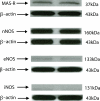Angiotensin-(1-7) inhibits neuronal activity of dorsolateral periaqueductal gray via a nitric oxide pathway
- PMID: 22728059
- PMCID: PMC3401242
- DOI: 10.1016/j.neulet.2012.06.031
Angiotensin-(1-7) inhibits neuronal activity of dorsolateral periaqueductal gray via a nitric oxide pathway
Abstract
The midbrain periaqueductal gray (PAG) is a neural site for several physiological functions related to cardiovascular regulation, pain modulation and behavioral reactions. Recently, angiotensin-(1-7) [Ang-(1-7)] has been considered as an important biologically active component of the renin-angiotensin system in the CNS. The purpose of this study was to determine (1) existence of Ang-(1-7) receptor, Mas-R, within the dorsolateral PAG (dl-PAG), (2) the role for Ang-(1-7) in modulating activity of dl-PAG neurons, and (3) the mechanisms by which Ang-(1-7) plays a regulatory role. Western blot analysis showed that Mas-R appears within the dl-PAG. Whole cell patch-clamp recording demonstrated that the discharge rates of dl-PAG neurons were decreased from 4.35±0.32 Hz of control to 1.06±0.34 Hz (P<0.05, vs. control) by 100 nM of Ang-(1-7). With pretreatment of A-779, a Mas-R inhibitor, the discharge rate was 4.66±0.62 Hz (P>0.05, vs. control) during infusion of Ang-(1-7). Additionally, neuronal nitric oxide synthase (nNOS) was largely localized within the dl-PAG among the three isoforms. The effects of Ang-(1-7) on neuronal activity of the PAG were attenuated in the presence of S-methyl-L-thiocitrulline (SMTC), a nNOS inhibitor. The discharge rates were 4.21±0.39 Hz in control and 4.09±0⋅47 Hz (P>0.05, vs. control) when Ang-(1-7) was applied with pretreatment of SMTC. Those findings suggest that Ang-(1-7) plays an inhibitory role in the dl-PAG via a NO dependent signaling pathway. This offers the basis for the physiological role of Ang-(1-7) and Mas R in the regulation of various functions in the CNS.
Copyright © 2012 Elsevier Ireland Ltd. All rights reserved.
Figures




Similar articles
-
Role of angiotensin-(1-7) and Mas-R-nNOS pathways in amplified neuronal activity of dorsolateral periaqueductal gray after chronic heart failure.Neurosci Lett. 2014 Mar 20;563:6-11. doi: 10.1016/j.neulet.2014.01.025. Epub 2014 Jan 25. Neurosci Lett. 2014. PMID: 24472567 Free PMC article.
-
Angiotensin-(1-7) increases neuronal potassium current via a nitric oxide-dependent mechanism.Am J Physiol Cell Physiol. 2011 Jan;300(1):C58-64. doi: 10.1152/ajpcell.00369.2010. Epub 2010 Oct 27. Am J Physiol Cell Physiol. 2011. PMID: 20980550 Free PMC article.
-
Role of GABA receptors in nitric oxide inhibition of dorsolateral periaqueductal gray neurons.Neuropharmacology. 2008 Mar;54(4):734-44. doi: 10.1016/j.neuropharm.2007.12.008. Epub 2008 Jan 28. Neuropharmacology. 2008. PMID: 18222497 Free PMC article.
-
Neuronal nitric oxide synthase and human vascular regulation.Trends Cardiovasc Med. 2009 Nov;19(8):256-62. doi: 10.1016/j.tcm.2010.02.007. Trends Cardiovasc Med. 2009. PMID: 20447567 Free PMC article. Review.
-
Role of neuronal nitric oxide synthase on cardiovascular functions in physiological and pathophysiological states.Nitric Oxide. 2020 Sep 1;102:52-73. doi: 10.1016/j.niox.2020.06.004. Epub 2020 Jun 23. Nitric Oxide. 2020. PMID: 32590118 Free PMC article. Review.
Cited by
-
AT2 and MAS (but not AT1) angiotensinergic receptors in the medial amygdaloid nucleus modulate the baroreflex activity in rats.Pflugers Arch. 2019 Sep;471(9):1173-1182. doi: 10.1007/s00424-019-02301-3. Epub 2019 Aug 8. Pflugers Arch. 2019. PMID: 31396758
-
Regional Specific Modulation of Stress-Induced Neuronal Activation Associated with the PSD95/NOS Interaction Inhibitor ZL006 in the Wistar Kyoto Rat.Int J Neuropsychopharmacol. 2017 Oct 1;20(10):833-843. doi: 10.1093/ijnp/pyx053. Int J Neuropsychopharmacol. 2017. PMID: 28977524 Free PMC article.
-
ACE2-Ang-(1-7)-Mas Axis in Brain: A Potential Target for Prevention and Treatment of Ischemic Stroke.Curr Neuropharmacol. 2013 Mar;11(2):209-17. doi: 10.2174/1570159X11311020007. Curr Neuropharmacol. 2013. PMID: 23997755 Free PMC article.
-
Evaluation of analgesic activity of perindopril in albino mice.J Adv Pharm Technol Res. 2014 Jul;5(3):129-33. doi: 10.4103/2231-4040.137423. J Adv Pharm Technol Res. 2014. PMID: 25126534 Free PMC article.
-
Shedding Light on the Pharmacological Interactions between μ-Opioid Analgesics and Angiotensin Receptor Modulators: A New Option for Treating Chronic Pain.Molecules. 2021 Oct 13;26(20):6168. doi: 10.3390/molecules26206168. Molecules. 2021. PMID: 34684749 Free PMC article. Review.
References
-
- Bandler R, Carrive P, Zhang SH. Integration of somatic and autonomic reactions within the midbrain periaqueductal gray: Viscerotopic, somatotopic and functional organization. Prog. In Brain Res. 1991;87:269–305. - PubMed
-
- Becker LK, Etelvino GM, Walther T, Santos RAS, Campagnole-Santos MJ. Immunofluorescence localization of the receptor Mas in cardiovascular-related areas of the rat brain. Am J Physiol. 2007;293:H1416–H1424. - PubMed
-
- Behbehani MM. Functional characteristics of the midbrain periaqueductal gray. Prog. Neurobiol. 1995;46:575–605. - PubMed
-
- Brooks VL. Interactions between angiotensin II and the sympathetic nervous system in the long-term control of arterial pressure. Clin Exp Pharmacol Physiol. 1997;24:83–90. - PubMed
-
- Bruner CA, Kuslikis BI, Fink GD. Effect of inhibition of central angiotensin pressor mechanisms on blood pressure in spontaneously hypertensive rats. J Cardiovascular Pharmacol. 1987;9:298–304. - PubMed
Publication types
MeSH terms
Substances
Grants and funding
LinkOut - more resources
Full Text Sources
Miscellaneous

